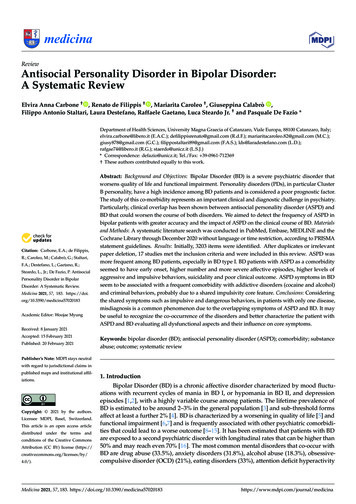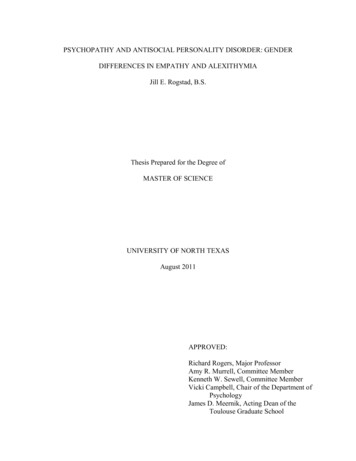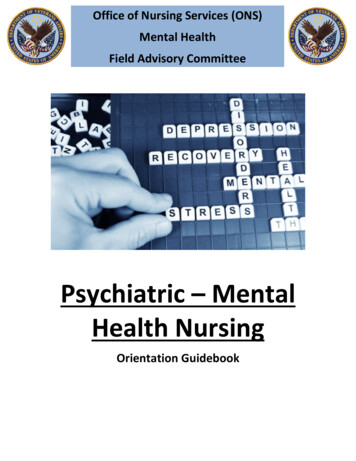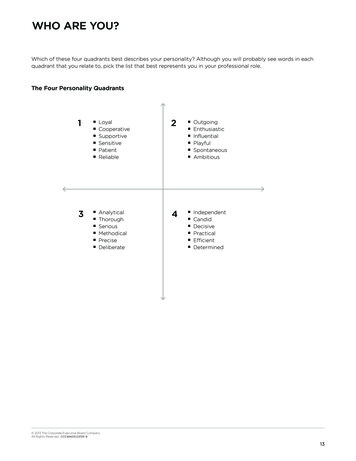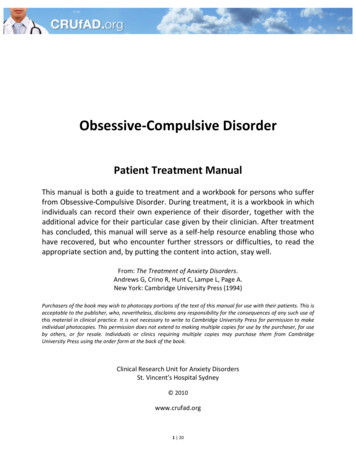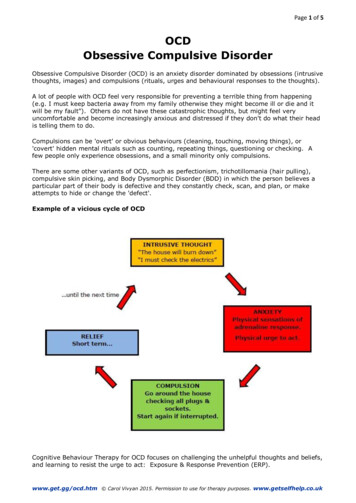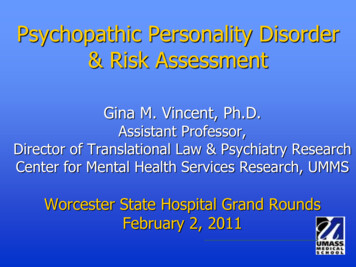
Transcription
Psychopathic Personality Disorder& Risk AssessmentGina M. Vincent, Ph.D.Assistant Professor,Director of Translational Law & Psychiatry ResearchCenter for Mental Health Services Research, UMMSWorcester State Hospital Grand RoundsFebruary 2, 2011
What is Psychopathy?
Personality Disorder Chronic disturbance in relating to self,others, and the environment Culturally abnormalEvident in multiple domains of functioningEvident across situationsClinically significant distress or impairmentEarly onset and stable over timeNot due to another mental disorderNot due to medical condition
Psychopathic Personality DisorderPsychopathy is a personality disorder with aspecific symptom ientAffectiveExperienceImpulsiveBehavioralStyle
Psychopathic PD Synonymous with Antisocial PD (DSM-IV) Dyssocial PD (ICD-10) Sociopathic PD“This pattern [of pervasive disregard forothers] has also been referred to aspsychopathy, sociopathy, or dyssocial PD.”(APA, 2000, p. 702)
Psychopathy Checklist - Revisedvs. ers(100%)
Clinical Forensic PsychopathyAssessment Tools
Psychopathy is DimensionalHare Psychopathy Checklist (PCL-R; 2003)Gold standard forensic assessment conductedusing all available information (file interview) 20 items rated on 3-point scale Absent 0; Possible/partial 1; Present 2Glibness/superficial charmGrandiose sense of self-worthLack of remorse or guiltCallous/lack of empathyTotal scores range from 0 to 40000011112222
Psychopathy: The ParalimbicDysfunction Hypothesis (Kiehl, 2006)Error-related negativityEmotional lexical decisionAffective memory taskAffective picture taskAbstract lexical decisionVisual oddball taskAuditory oddball taskParalimbic system
Lexical Decision TaskLetter strings presented50% nonwords; 50% wordsbekemakecerekillISI of 1 - 2 secshare
What Causes Psychopathy? Birth complications/fetal brain damagelead to executive dysfunction (Moffitt)Inherited (Viding)Trauma induced (Porter)
OKAY . SO WHAT DOESPSYCHOPATHY HAVE TO DOWITH ME?
Clinical Relevance Prevalence of psychopathy ranges from 10% to12% among male forensic patients (PCLR M 21.5)Negatively correlated or uncorrelated with MI Bipolar DisorderDepressionSchizophreniar .17r -.17 - .04r -.15 - .00Highly correlated with substance abusecluster B PD’s, andattempted malingering
Clinical Relevance:Institutional Misconduct On average, male forensic psychiatric patientswith high PCL-R or PCL:SV scores, relative tolow scorers, are more likely to Be physically and verbally aggressiveHave violent & non-violent infractions (r .25 .35)Require restraint or seclusionViolate hospital rulesComplain about staff (35% of complaints)Suicide Risk?
Legal Relevance Recommended use: Institutional &community risk management & treatmentPretrial – not recommended Sentencing Diversion, bail, CST, NGRI, juvenile waiverAlternative sanctions, indeterminate (DO) orcapital sentencing, placement decisionsCorrections Institutional classification, parole hearings,community supervision/notification
Legal Relevance Civil law Civil commitment & release Inpatient, outpatient, indeterminate(SVP, SPD) Restraining orders Immigration/deportation Workplace violence Parenting capacity
Implementation of the PCL Field study of PCL-R’s conducted forsexually violent predator cases foundunacceptable reliability (ICC .39;Boccaccini et al., 2008; Murrie et al., 2008) Compared to ICCs .86 to .94 in the labImplementation must be methodical tomaintain the integrity of the tool Intensive training and booster trainingsWritten policy about “when” and “how” it willbe used
PSYCHOPATHY AND RISKASSESSMENT
Psychopathy: Causal Risk Factorfor Violence? Relative to other offenders, psychopathicadult male offenders, as assessed by a HarePsychopathy Checklist (PCL-R/PCL:SV), Start their criminal careers earlier,Are 5 to 10 times as likely to violently reoffend,Commit more severe acts of violence, andDifferent types of violence – different victims.Meta-analyses show the relation betweenPCL scores and violence is r .30 to .35
Causal Mechanisms Impulsivity - sensation-seeking, failure toconsider alternatives to or consequencesof crimeUnemotionality - inability to consider orappreciate consequences of crimeSuspiciousness - perception of hostileintent in othersArrogance - desire to exert power orcontrol over others
Psychopathy is the Best “Single”Predictor of General Violence “Indeed, failure to consider psychopathywhen conducting a risk assessment maybe unreasonable (from a legalperspective) or unethical (from aprofessional perspective).” (Hart, 1998,pg. 17)
Conclusions: Psychopathy &Risk Assessment Psychopathy should be assessed as part ofcomprehensive correctional or forensic riskassessments by trained professionalsusing proper procedures The presence of psychopathy compels aconclusion of high risk The absence of psychopathy does notcompel a conclusion of low riskRisk, Need, & Responsivity factor
PSYCHOPATHY ANDTREATMENT
Adult Psychopaths in Treatment(Skeem, Monahan, & Mulvey, 2002) Dose – Response RelationshipEffect of Treatment dosage on N 871civil psychiatric inpatientsPotentially psychopathic (SV 12),violence 2.5X as likely if 6 sessions Confirmed psychopaths (SV 18),violence 3.5X more likely if 6 sessions Conclusion: Adequate doses of treatmenterased the moderating effects ofpsychopathy.
Aggressive Behavioral Control (ABC)Program, RPC, 5-year follow-up(Olver & Wong, 2009)70Recidivism %6050403020100Tx CompleteTx IncompleteUntreatedMatched Control
Importance of Early Intervention: YouthTreatment Study 2-year f-up(Caldwell et al., 2006)80706050403020Tx as usualMJTC100Any recidivism violent recidivismAll Serious Offenders; PCL:YV Total / 27
What Seems to Work? Well-trained staffDecrease attrition - Keep those with psychopathictraits in treatmentPeer environment - an even ratio of psychopathsto nonpsychopaths in group settingsFocus on motivational strengths Status orientation, novelty-seeking, need forinterpersonal contact, need for controlUse highly structured evidence-based trt CBT, DBT, Relapse prevention model with selfmonitoring
RISK ASSESSMENT INGENERAL
Psychopathy is Not Enough Psychological factors can play a causalroleAntisocial attitudesPersonality disorder Substance use Social conflict Antisocial peersSocial disadvantageCrime andViolence
Specificity of Risk AssessmentGeneral CrimeViolenceSexual ViolenceSpousal Violence
Specificity of Risk Assessment Most risk factors for general criminalityalso are associated with violenceSome violence risk factors are notassociated with general criminalitySome forms of violence have unique orspecific risk factors
Why is a Risk Assessment Tool Important? Need a method of decision-making that Promotes consistency between evaluatorsIdentifies outcomes of interestTakes all relevant risk factors into accountTakes the individual patient into accountCan inform treatment, management,preventionCan facilitate communication between partiesIs reviewable, accountable, or transparent
History of Decision-Making Unstructured Clinical/ProfessionalJudgmentStructured Decision-Making Two types
Approaches to Decision-Making: Actuarial Actuarial Assessment PredictionRisk level is determined based on a formulaGenerally contains factors based on the knownempirical association with riskExamples Violence Risk Assessment Guide (VRAG)Static-99
Approaches to Decision-Making: Actuarial Limitations: Items often lack relevanceItems often not capable of changeDo not account for idiosyncratic factors (unlessoverride is an option)Probability estimates have substantial marginsof error
Structured Professional Judgment:A Model of Risk Assessment Relies on clinical expertise within a structuredapplication (empirical risk factors judgment)Logical selection of risk factors Review of scientific literatureNot sample-specific (enhances generalizability)ComprehensiveOperational definitions of risk factors Explicit coding proceduresPromotes reliability
Instruments: Average AUCs(Guy, 2008)InstrumentSVR-20Numeric Score Summary RiskRatings (L,M,H).61.70(sexual violence)RSVP.63.73.63.73.75.79.67.79(sexual violence)SARA(spousal violence)SAVRY(youth physical violence)HCR-20(adult physical violence)
Caveats: Interpret With Caution Risk assessments cannot be used to makespecific predictions about the behavior ofindividuals with any reasonable degree ofaccuracyA conclusion of high risk does notnecessarily require incapacitation
Take Home Messages Psychopathy is a personality disorder thatis a necessary, but not sufficient, part ofrisk assessment High likelihood for institutional & communityviolenceIt is one risk factor, not a risk assessmentImportant for risk management, treatment,and release planning/decisionsMust be implemented into a systemmethodically
Take Home Messages Risk assessments increase consistency &validity of decisions Preference in a forensic or civil psychiatricsystem towards structured professionaljudgment approachesSTART – dynamic institutional risk HCR-20 – community risk among mental healthpopulations SONAR or RSVP – sexual violence risk SARA – spousal violence risk
Psychopathy is a personality disorder that is a necessary, but not sufficient, part of risk assessment High likelihood for institutional & community violence It is one risk factor, not a risk assessment Important for risk management, treatment, and release planning

